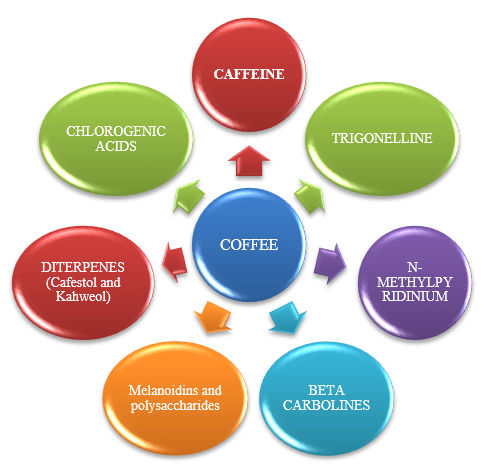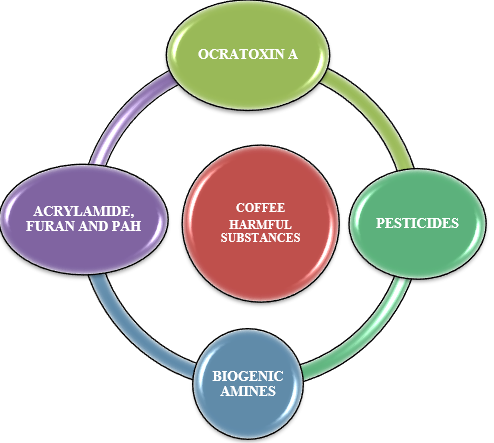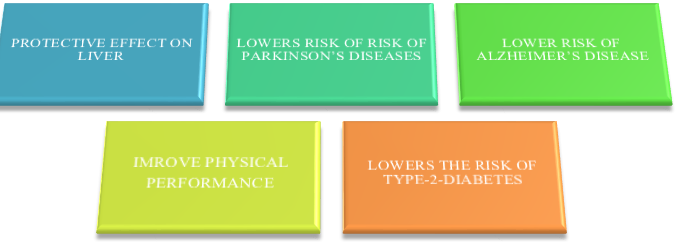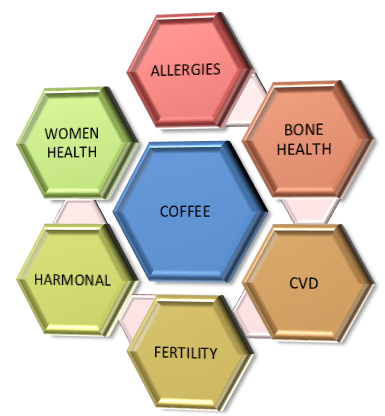Introduction
Coffee is the world’s beloved drink. It contains a complex mixture of chemicals that provide important amounts of chlorogenic acid and caffeine. It is the most important agricultural commodity in international trade. Arabica coffee and Robusta coffee are the two major species used in the coffee production. In fact, Coffee offers few nutrients, but it contains more than thousands of chemicals which occur naturally such as carbohydrates, lipids, nitrogenous compounds, vitamins, minerals, alkaloids and phenolic compounds, a number of which are potentially healthful (and others potentially harmful). The character impact compounds of coffee are not present in the green state but are mainly formed during roasting. The findings on the potential harmful effects of coffee consumption have historically been reported, and the great saint Jagadguru Sri Kanji Maha Periavar from Tamil Nadu Urged not to have either coffee or tea.
Bioactive componenets present in coffee
The term ‘Bioactive Compounds’ commonly refers to minor food constituents that exert biological functions other than nutritional functions. These compounds are commonly found in plants, and in a few animals that feed on them, and their chemical structures and biological functions vary widely.
Caffeine
(1,3,7-trimethylxanthine) is an alkaloid compound which is naturally occurring compound of coffee. A Cup of coffee gives an energizing jolt because it naturally contains caffeine. The Linus Pauling Caffeine Institute, USA, notes that caffeine is quickly absorbed by all our body’s tissues, including the brain, and stimulates the nervous system. The amount of caffeine depends on the type of coffee and method of preparations. A standard cup of brewed coffee gives us 100 milligrams of caffeine. The high amount of caffeine occurs in the blood flow within 15-45 min of consumption, peaking approximately 60 minutes post-consumption. It freely crosses the blood- brain barrier like lipid soluble compound, and it has influence in our neural function attributed to energy balance. Caffeine is rapidly absorbed through the gastrointestinal (GI) tract and moves through cellular membranes with the same efficiency as when it is absorbed and circulated to tissue. Caffeine is metabolized by the liver and results in metabolites like paraxanthine (1,7-dimethylxanthine), theophylline (1,3-dimethyl-xanthine), and theobromine (3,7-dimethyl-xanthine) by the action of an enzyme.
Trigonelline
Beans from C. arabica species contain higher amounts of this compound, compared with C. canephora, and as with chlorogenic acids, trigonelline undergoes changes and degradation during roasting; hence, dark roasted coffees contain low amounts. However, 10–20% of the original amount of trigonelline is converted into Nicotinic Acid (Niacin).1 In addition to its vitamin function, niacin is also involved in other bioactive functions, presenting antidiabetic, 2 antioxidant and hepatoprotective. 3 effects in vitro and in animal studies.
N-Methylpyridinium
The compound N-Methylpyridinium and other pyridinium derivatives are additional thermal degradation products generated by the decarboxylation of Trigonelline.
β-carbolines
These are alkaloids formed in coffee mainly during roasting and the two identified β-carbolines in coffee are norharman and harman. The total concentration of these compounds in the brew is highly variable in the literature, from 4 to 80 µg per 100 mL, but typical concentrations are reported to be in the range of 4–20 µg per 100 mL, being primarily dependent on the coffee species. Roasted C. canephora beans have consistently higher amounts of β-carbolines than C. arabica beans. 4, 5, 6
Melanoidins and polysaccharides
Coffee melanoidins have gained importance because of their contribution to, the antioxidant and antimicrobial effects of coffee. 7 This is, due to the incorporation of Chlorogenic acids and other bioactive compounds into their structure during roasting.4 As melanoidins are not digested, they may act, in combination with coffee polysaccharides (mainly galactomannans and type II arabinogalactans), as soluble dietary fibres. They are largely indigestible and thus fermented in the gut.8, 9 A recent study concluded that the consumption of 0.5–2 g melanoidins per day (present in 2–5 cups) contributes up to 20% of the recommended 10 g of daily soluble dietary fibre intake. It has also been hypothesized that these substances may stimulate the growth of beneficial bacteria in the lower digestive tract.10
Coffee consumption has been associated with higher concentrations of serum total cholesterol and low density lipoprotein cholesterol. Cafestol and kahwoel are two diterpenes found in coffee oil. Diterpenes are the main cholesterol-raising compounds in coffee, but they are mostly removed by paper filters. Therefore, unfiltered coffee is a significant source of diterpenes, whereas the consumption of filtered coffee results in very little increase in serum cholesterol.
Chlorogenic acid is one of the biologically active compounds that found in coffee, slow absorption of carbohydrate. It is one chemical compound in coffee which found in Easter family and formed in between trans- cinnamic and quinic acid which are useful nutritional phenol. It also is known as 5-O-caffeoylquinic acid which ranges in between 70-350 mg in a 200 ml (7-oz) cup of coffee in which it contains about 35-175 Mg of caffeic acid.6
Harmful components present in coffee
A number of Studies highlighted that coffee as a potential source of certain unwanted/toxic constituents, such as Ochratoxin A, 11 Furan, 12, 13 Heavy Metals. 14, 15 A few compounds derived from microbial contamination (Ocratoxin A, Biogenic Amines), Pesticides or Chemical reactions that occur during the roasting process (mainly acrylamide furan and polycyclic aromatic hydrocarbons– PAH) have been of concern to health authorities such as the Food and Drug Administration (FDA), Food and Agriculture Organization of the United Nations (FAO) and the European Food Safety Authority (EFSA)
.
Ocratoxin A derived from green bean contamination with mould and can be avoided by carefully harvesting, processing and storing coffee, which is reflected in good quality. In the European Union, regulation 1881/2006 states that for roasted coffees, the maximum limit is 5 µg per kg.
Pesticides comprise a large number of substances belonging to different chemical groups, which are used to control plant diseases, pests or weeds. They can be neurotoxic or inhibit vital metabolic reactions in living beings, targeting different mechanisms, and individual pesticides present different levels of toxicity. In order to protect human safety and health resulting from pesticide application during coffee production, many countries have put these chemicals under strict legislation and surveillance. In the United States, the FDA establishes the maximum amount of a pesticide allowed to remain in food, as part of the process of regulating pesticides. Presently, tolerance limits for about 43 pesticides in coffee are listed by the FDA. In Japan, the maximum tolerated residual limits are amongst the lowest (often 0.01 ppm).
Acrylamide, furan and PAH are derived from reactions that occur during roasting, more specifically Maillard reaction and pyrolysis33, the US FDA (FDA, 2016) reported that coffee is a significant source of acrylamide exposure for adults, and European Commission’s recommended indicative value is 450 µg acrylamide per kg of roast and ground coffee, a level which is generally achievable for commercial products.
Furan, Hydroxy Methyl Furfural (HMF) and Furfural are heterocyclic, low molecular weight molecules with a furan ring and potential carcinogenicity in common. Furan has been classified as a possible carcinogen (Group 2B) by the International Agency for Research on Cancer (IARC). In coffee, these compounds are formed during the roasting stage mainly via thermal degradation/Maillard reaction of reducing sugars, alone or in combination with amino acids or via the thermal degradation of amino acids.
PAH, from which benzo[a]pyrene is the most relevant from a toxicity point of view, can be formed in coffee and other foods that are severely roasted or exposed to very high temperatures. This compound is classified by the IARC as probably carcinogenic to humans. However, the level of exposure to PAH from coffee is low and within the safe limits set by International Agencies.16
Biogenic amines are organic bases of low molecular weight that participate in the regular metabolic processes of plants, microorganisms and animals. They are produced in the body and can also be provided by the diet and from the microbial flora of the intestine; at high concentrations, however, they can pose a toxicological risk. Examples include histidine, tyramine, tryptamine, cadaverine and putrescine. Histidine is the most toxic and is associated with a hypotensive effect and headaches. Putrescine, cadaverine and tyramine seem to be toxic in higher doses in animals, but the individual sensitivity to these compounds in humans varies considerably and causes different responses. In coffee, biogenic amines originate from the action of microbial enzymes on amino acids during fermentative processes, suggesting inappropriate storage or low-quality defective fermented seeds. Roasting may deconjugate and increase the amount of some free biogenic amines, whilst most other amines are degraded.17, 1
Coffee too has its health benefits
Coffee intake reduces the risk of liver damage in people at high risk for liver disease including hepatic injury, cirrhosis, and hepatocellularcarcinoma. Pyridinium derivatives have also been reported to present antioxidant/chemopreventive, 18 Hepatoprotective, 19 vasoprotective 20 and antithrombotic effects. 21 A total number of 72 (5.6%) studies have investigated to identify the effect of coffee consumption on liver disorders, namely, liver function/enzymes in general and gallstones/gallstone disease. Overall, this evidence, largely from observational studies, is showing coffee to have a protective effect on the liver.
Coffee consumption is also inversely associated with the risk of Parkinson’s disease in men and women who have never used postmenopausal estrogen. 22 The risk of Alzheimer’s disease is lower in those who regularly consume caffeine containing coffee than in those who do not drink it.23 Many studies show that coffee consumption may help prevent several chronic diseases. In particular, long-term coffee consumption is associated with significant dose dependent reductions in the risk of developing Type-2 Diabetes. 24
Trigonelline has gained importance due to its potential contribution to the protective effect of coffee against diseases. In vitro and animal studies have reported different involvements of trigonelline against type 2 diabetes, 2 as well as neuroprotective, 25, 26 antitumour 27 and phytoestrogenic effects. 1 It has been reported that like trigonelline, n-methylpyridinium promoted higher glucose utilization in liver cells, stimulating cellular energy metabolism and contributing to the protective effect against type 2 diabetes. 28
β-carbolines have been recently associated with poten- tially positive effects, including neurological ones, with antidepressive and neuroprotective properties. It has also been suggested that they may reduce the risk of diabetes.
Chlorogenic acid can able to exert important roles in glucose and lipid metabolism regulation and on the other related disorders, e.g., diabetes, cardiovascular disease (CVD), obesity, cancer, and hepatic steatosis. 11 As with chlorogenic acids, 29 it has been hypothesized that melanoidins can enhance immune-stimulating properties and contribute significantly to reducing the risk of colon cancer 30, 31, 32 which might occur in different ways: i) by increasing the elimination rate of carcinogens through higher colon motility and faecal output, ii) by decreasing colon inflammation through improved microbiota balance (prebiotic effect) and iii) by serving as a ‘sponge’ for free radicals in the gut.4
Allergy
Coffee consumption associated with risk of Allergies. Anaphylaxis symptoms arises due to caffeine present in coffee. 33
Bone Health
The most frequently reported condition associated with coffee consumption is poor bone health. These adverse effect is reported only in lean compared to overweight/ obese individuals, 34 and in females, not males.35 with high daily coffee consumption,36, 37 Caffeine leads to a slight decrease in the efficiency of calcium absorption in gastrointestinal tract. Thus, an adequate intake of calcium and vitamin D and elimination of coffee intake to 2–3cups/day may help reduce the risk of osteoporosis and its related fracture particularly in elderly adults.
Cardio Vascular Disease
Coffee may show unfavourable acute cardiovascular and metabolic effects with regard to endothelial function. Risks of raised blood pressure/hypertension in coffee consumers are also apparent within the literature, and this pressor effect may be caused by a coffee-induced increase in adrenaline concentrations. 38, 39, 40 Coffee consumers also appear to be at an increased risk of higher homocysteine concentrations, an independent risk factor for CVD. 41, 42 Caffeine is a major component of coffee, and appears to exert most of its biological effects through the antagonism of the adenosine receptor. Adenosine is an endogenous inhibitory neuromodulator that prompts feelings of drowsiness, and thus caffeine induces generally stimulatory effects in the Central Nervous System. In addition, the physiological effects of caffeine intake include acute elevation of blood pressure, increasing metabolic rate, and diuresis. It should be considered that coffee does have modest cardiovascular effects such as tachycardia, high blood pressure, and occasional arrhythmia. The acute effects of coffee on the cardio vascular system might arise in the time immediate to coffee intake or in more susceptible individuals. Coffee consumption has been associated with higher concentrations of serum total cholesterol and low density lipoprotein cholesterol. Cafestol and kahwoel are two diterpenes found in coffee oil. Diterpenes are the main cholesterol-raising compounds in coffee, but they are mostly removed by paperfilters. Therefore, unfiltered coffee is a significant source of diterpenes, whereas the consumption of filtered coffee results in very little increase in serum cholesterol. 43 A direct dose-dependent effect is also evident and another study has quantified a 1.66 and 1.58 mg/dL increase in Low Density Lipoprotein (LDL)-cholesterol per daily cup of coffee consumed by men and women, respectively. 44, 45 Moreover, abstinence from coffee for at least 6 weeks will lower cholesterol concentrations in the general population, 46 and in hypercholesterolemic patients. 47 This negative effect of coffee on cholesterol concentrations, is owing to higher concentrations of diterpenes (kahweol and cafestol) in such coffee preparations. 48
Fertility
Coffee drinking decrease fertility in female. Reduce a chance of woman’s to be pregnant by about 27%. Coffee intake cause male infertility azoospermia or oligospermia. Influence semen parameters, but also sperm DNA integrity. 49, 50
Harmonal Problem
Caffeine consumption Menstrual disturbances; premenstrual syndrome; menstrual function (menstrual pattern, dysmenorrhea); menopausal/climacteric symptoms (hot flashes and night sweats); onset of menopause; salivary cortisol; sex hormone and other hormone levels (estradiol, testosterone); erectile dysfunction; anterior pituitary hormones. 51
Women Health
Females who drink 31-250 mg of caffeine/day had a 3/2-fold rise in the chances of developing fibrocystic breast disease and females who drink over 500 mg/day had a double increase in the probability of developing Breast tissue cysts in women cysts. 51 Drinking coffee when pregnant, caffeine will also reach the foetus, and child is highly sensitive to caffeine. Therefore, heavy weight coffee drinker while pregnant, at least reduce coffee intake not more than one cup per day.
Additional risks of coffee consumption were apparent for pregnant women (for example, relative to pregnancy complications, birth outcomes, or the health of the infant). Although these risks were noted in 26 out of the 50 studies, many were linked with higher coffee consumption. 52 Indeed, some studies did report positive (beneficial) effects on certain pregnancy/infant health outcomes, such as the risk of pre-term delivery, 53 or childhood acute leukemia. 54 Drinking coffee when pregnant, caffeine will also reach the foetus, and child is highly sensitive to caffeine. Therefore, during pregnancy the coffee intake shall be reduced to not more than one cup per day.
Conclusion
Coffee consumption is used for social activity, leisure, improvement of work performance. The negative effects of coffee tend to emerge in excessive drinking, so it is the best to avoid heavy coffee intake. This review covers the health benefits and adverse effects associated with drinking coffee. Overall, results of this review show that the risks of coffee consumption outweigh consumer’s health benefits clearly for the majority of health outcomes considered. Hence, we should find alternative for coffee such as our traditional health drinks, ragi malt, gruel/porridge prepared from millets and nuts to lead a healthy life.




